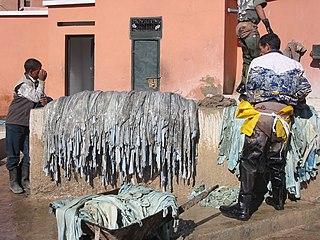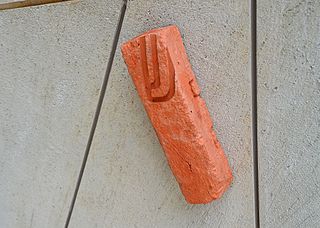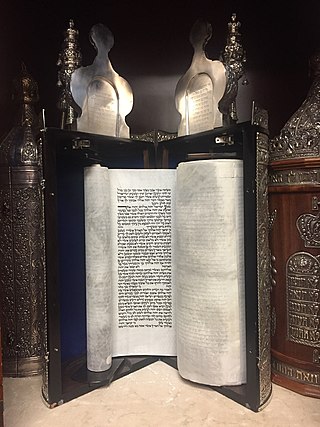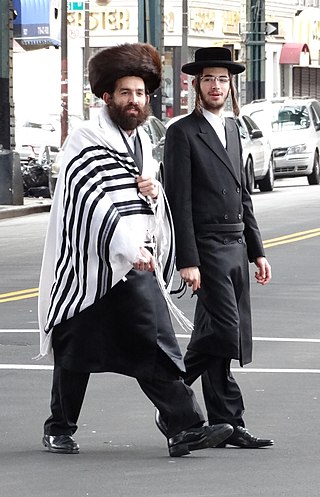
The Torah is the compilation of the first five books of the Hebrew Bible, namely the books of Genesis, Exodus, Leviticus, Numbers and Deuteronomy. It is known as the Pentateuch or the Five Books of Moses by Christians. It is also known as the Written Torah in Jewish tradition. If meant for liturgic purposes, it takes the form of a Torah scroll. If in bound book form, it is called Chumash, and is usually printed with the rabbinic commentaries.

Tanning is the process of treating skins and hides of animals to produce leather. A tannery is the place where the skins are processed.

A tallit is a fringed garment worn as a prayer shawl by religious Jews. The tallit has special twined and knotted fringes known as tzitzit attached to its four corners. The cloth part is known as the beged ("garment") and is usually made from wool or cotton, although silk is sometimes used for a tallit gadol.

Tefillin, or phylacteries, are a set of small black leather boxes with leather straps containing scrolls of parchment inscribed with verses from the Torah. Tefillin are worn by adult Jews during weekday morning prayers. In Orthodox and traditional communities, they are worn solely by men, while some Reform and Conservative (Masorti) communities allow them to be worn by any gender. In Jewish Law (halacha), women are exempt from most time-dependent positive commandments, which include tefillin.
In its primary meaning, the Hebrew word mitzvah refers to a commandment commanded by God to be performed as a religious duty. Jewish law in large part consists of discussion of these commandments. According to religious tradition, there are 613 such commandments.

A mezuzah is a piece of parchment inscribed with specific Hebrew verses from the Torah, which Jewish followers of Rabbinical Judaism affix to the doorposts of their homes. These verses are the Biblical passages in which the use of a mezuzah is commanded ; they also form part of the Shema prayer.
Duchsustus is the name of a type of parchment used for religious writings in Judaism. It is originally a Greek word and one of three Talmudic names for animal skin. The other two are klaf and gevil. The meanings of these terms, however, are the subject of controversy in Jewish law. According to the Talmud, a sefer Torah should, ideally, be written on gevil, but may also be on klaf, tefillin must be written on klaf, and mezuzot may be written on duchsustus, klaf, or gevil. This instruction is dated to Moses at Mount Sinai. Duchsustus is the animal's dermis, klaf is the epidermis, and gevil is both layers tanned and unseparated.

A Sefer Torah or Torah scroll is a handwritten copy of the Torah, meaning the five books of Moses. The Torah scroll is mainly used in the ritual of Torah reading during Jewish prayers. At other times, it is stored in the holiest spot within a synagogue, the Torah ark, which is usually an ornate curtained-off cabinet or section of the synagogue built along the wall that most closely faces Jerusalem, the direction Jews face when praying.
Jacob ben Meir, best known as Rabbeinu Tam, was one of the most renowned Ashkenazi Jewish rabbis and leading French Tosafists, a leading halakhic authority in his generation, and a grandson of Rashi. Known as "Rabbeinu", he acquired the Hebrew suffix "Tam" meaning straightforward; it was originally used in the Book of Genesis to describe his biblical namesake, Jacob.

Opanci are traditional peasant shoes worn in Southeastern Europe. The attributes of the opanci are a construction of leather, lack of laces, durable, and various endings on toes. In Serbia, the design of the horn-like ending on toes indicates the region of origin, though this specific design is not exclusive to Serbia. The opanci are also considered as the traditional peasant footwear for people in the Balkan region. In Bulgaria they are referred to as "tsarvuli".

Klaf or Qelaf is the designation given a particular piece of skin. The Talmudic definition includes both the form of the skin and the way it is processed, in particular, that it must be tanned. Since the innovative ruling of Rabbeinu Tam it is primarily used to refer to parchment or vellum. It is one of the materials upon which a sofer writes certain Jewish liturgical and ritual documents.

Gevil or gewil or is a type of parchment made from full-grain animal hide that has been prepared as a writing material in Jewish scribal documents, in particular a Sefer Torah.
A masekhet is an organizational element of Talmudic literature that systematically examines a subject, referred to as a tractate in English.

A sofer, sopher, sofer SeTaM, or sofer ST"M is a Jewish scribe who can transcribe Sifrei Kodesh, tefillin (phylacteries), mezuzot and other religious writings.

Ktav Stam is the specific Jewish traditional writing with which holy scrolls, tefillin and mezuzot are written. Stam is a Hebrew acronym denoting these writings, as indicated by the gershayim punctuation mark. One who writes such articles is called a sofer stam. The writing is done by means of a feather and ink onto special parchment called klaf. There exist two primary traditions in respect to the formation of the letters, Ktav HaAshkenazi and Ktav HaSefardi, however the differences between them are slight.

Jewish religious clothing is apparel worn by Jews in connection with the practice of the Jewish religion. Jewish religious clothing has changed over time while maintaining the influences of biblical commandments and Jewish religious law regarding clothing and modesty (tzniut). Contemporary styles in the wider culture also have a bearing on Jewish religious clothing, although this extent is limited.
A law given to Moses at Sinai refers to a halakhic law for which there is no biblical reference or source, but rather was passed down orally as a teaching originating from Moses at Sinai. Such teachings have not been derived from any Talmudical hermeneutics, but known solely from the Jewish tradition.

The clothing of the people in biblical times was made from wool, linen, animal skins, and perhaps silk. Most events in the Hebrew Bible and New Testament take place in ancient Israel, and thus most biblical clothing is ancient Hebrew clothing. They wore underwear and cloth skirts.
Objects used in Jewish rituals are known collectively as Judaica. The conservation and restoration of Judaica takes into account the collective body of Jewish religious laws derived from the written and oral Torah known as halacha in order to properly care for these materials. This work involves identifying these objects and therefore knowing how any of these objects are traditionally handled, stored, exhibited, and generally cared for based on their use and significance.

Bating, a technical term used in the tanning industry to denote leather that has been treated with hen or pigeon manure, similar to puering where the leather has been treated with dog excrement, and which treatment, in both cases, was performed on the raw hide prior to tanning in order to render the skins, and the subsequent leather, soft and supple. Today, both practices are obsolete and have been replaced in the tanneries with other natural proteolytic enzymes.













